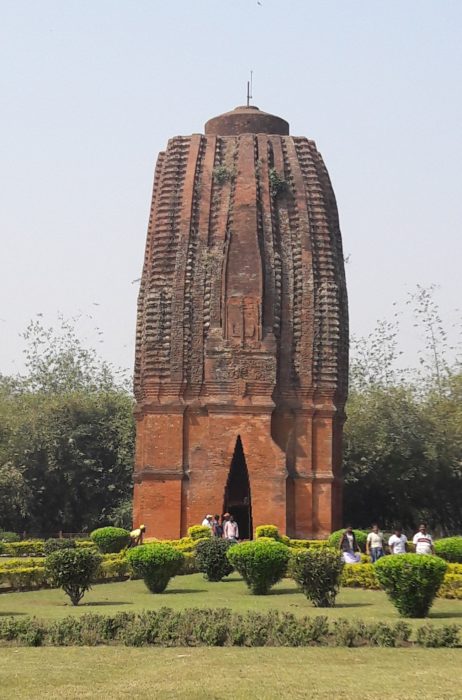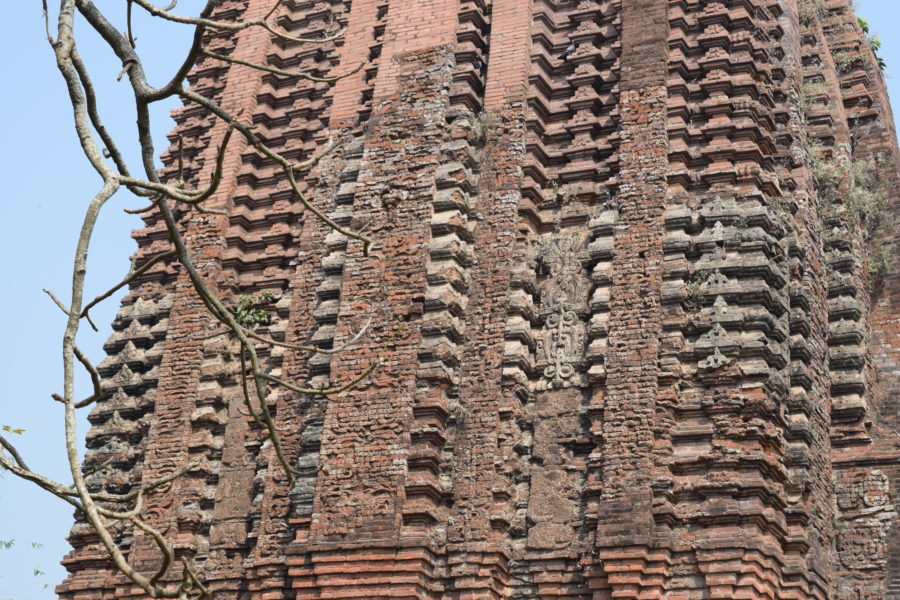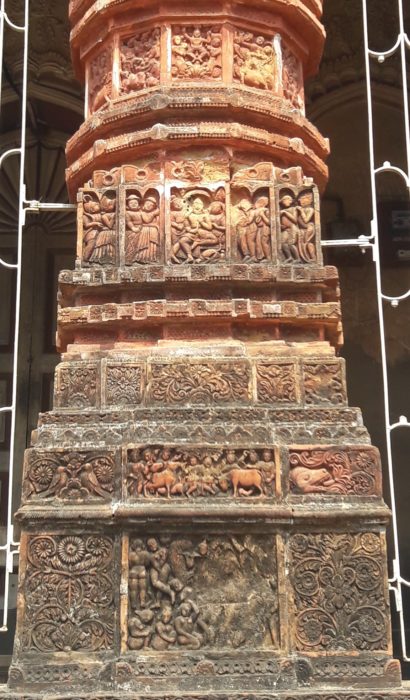26th March 2018 Kolkata, India
Baked earth

The pile of bricks was sitting just outside the entrance to the site.
The humble brick has been used for the construction of buildings for longer than recorded history. The myth of a ‘mother earth’ or ‘earth goddess’ is as old. Many ancient civilisations worshiped a female deity who represented the fertility of the soil. The Sumerians in Mesopotamia had Ki, the ancient Greeks Gaia, and Hindus have the goddess Parvati.
The bricks carried the word ‘Maa’ on one side, a transliteration of the Bengali (and Hindi) word for mother. I thought it a fitting name and took a photograph.
The bricks were outside a temple that we had just visited in the plains to the west of Kolkata. The temple was a splendid tower set in a beautiful garden, under the care of the Archaeological Survey of India (ASI). I had been invited to visit it by a group that wanted to draw more attention to the heritage of Bengal. I was visiting with my Kolkata based colleague from the Indian Ministry of External Affairs.
I have visited a few temples elsewhere and knew of those around the town of Bishnupur which were built 300-400 years ago. I hadn’t realised that there were so many brick temples all over the lower Ganges plain. My hosts wanted to show me others that were less well known.

The temple we had just visited was much older than those of Bishnupur. It was called Sat Deul and was about a millennium old, built in the ‘rehka deul’ style, which was common in the neighbouring state of Odisha. It rested on a plinth and had ridged outer walls tapering up to the top. It was a Jain temple and still had some of the original stucco, or rendering, on the exterior. It had lost its amalaka, a disk at the top of the temple, on top of which there would be a metal top in the shape of a pot, called a kalasa.

There were some labourers working on repairs at the temple when we visited. They were sure the temple was higher than 56 feet, as declared by the ASI. From a distance, the building listed gently to the right. It was a lovely edifice and had been sympathetically restored. Whatever its height, it was tall enough to impress me because of how long it had survived.

We then visited a very different temple in the nearby town of Debipur. It was called the Lakshmi Janardhan temple and was owned by a family who now lived elsewhere in Bengal. It was surrounded by other buildings, including a school, but the entrance was through an archway which beautifully framed the temple.
Compared to Sat Deul, the temple was a mere youngster, completed only 162 years ago. It was covered with tiles decorated with intricate patterns and scenes from the life of the Hindu gods. In places the delicate artwork has worn away, and other parts of the temple also needed repair.

There was a good reason for me – as British representative in West Bengal – to visit the temples. Later that day on our return to Kolkata, we visited the Christian cemetery in Bhowanipure. We were there to pay our respects to David McCutchion, who was buried there. He was a British academic who came to India in 1960 at first to teach, later to study, but sadly died in 1972 from polio at the young age of 41.
In his brief time in Bengal, he became a friend and collaborator of the great Bengali film director, Satyajit Ray. He also developed a passion for terracotta temples. He visited many with some Bengali collaborators and assembled a mass of photographic and other records on the temples. These are now held in the Victoria and Albert Museum in London.
After visiting the grave, we chatted about the temples over lunch. We discussed how such sites in the lower Ganges basin have relatively few visitors – unlike the temples at Bishnupur – and what could be done to to promote interest in them and increase the number of visitors. For lack of interest, they could still fall into ruin.

Among other things, we agreed they could perhaps be the subject of study for local school children. This might widen appreciation in the local community of local history and the role of the temples in the past. We considered how they could be incorporated into tours for foreign tourists, and advertised in all the local hotels, hostelries and homestays.
I also thought of the value that such sites could play for the local community. Whenever I take road trips out of Kolkata, I like to stop at a dhaba – roadside cafes common across India – and drink a cup of strong, sweet tea out of a small earthenware cup, as it is drunk in Bengal. I wanted the equivalent of a dhaba outside the temples.
I knew that I would have other questions about the temples after we parted. I hadn’t asked, for example why they are called terracotta, and not brick, temples. I supposed it was because of the decorated tiles on the sides of the temples. Terracotta – Italian for baked or cooked earth – sounds more poetic. Brick is an everyday, utilitarian word, and the temples I saw were special.
I have been in contact with other groups about the temples of Bengal, and there are plenty of articles about them. I look forward to visiting the temples at Bishnupur. For future visitors to Bengal, the baked earth buildings and clay tea cups are a special part of the region. You haven’t experienced Bengal properly if you have not seen a terracotta temple or drunk tea from a clay cup.
My visit was kindly organised by BAUL – the Bespoke Architectural and Unique Legacies of Bengal.
Amit Guha, a member of the Bengali community in London, wrote an article on the many types of terracotta temple, and another on David McCutchion’s work.
Blogger Rangan Datta writes extensively on the sites of interest in Kolkata and West Bengal.
I know there are many others interested in the temples. I should be delighted to hear from them and do more ‘temple hopping’.
I have always wondered how the bricks came into play in terms of construction in the Sub Continent. Before all the buildings were done by stones that were near the construction site.